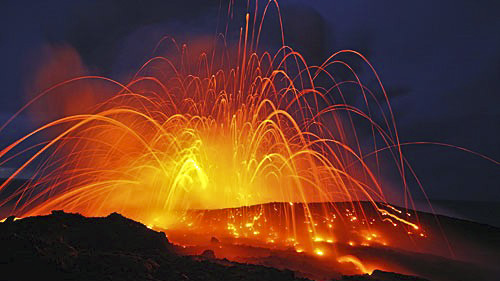
Even inside the cabin of a helicopter, the heat reaches blast furnace intensity as we hover over the mouth of Hawaii’s dramatically active volcano.
It was a phenomenal opportunity to be able to fly over Kilauea and follow its molten tongues to the sea during a stay on the Big Island after a recent cruise.
Kilauea has become a regular on the nightly news as its lava flows lap ever closer to homes of people who should have seen the risk of living alongside an active volcano that for centuries has been known as the mythical home of the Hawaiian fire goddess Pele. How did they even get permission to build here? It’s not as though they didn’t have any warning, since the volcano’s been blowing its top regularly since the 1980s.
The drama in real life outdoes any movie ever made about an unstoppable blob that can swallow up everything in its path. Hawaiians have two reactions: fear that their home is about to be reduced to cinders and fascination with the otherworldly show.

The Internet is full of “fun with lava” video clips. Folks dash out on the hot coals and scoop out shovelfuls of white hot ooze to play with.
And oh, the scientific discoveries: What happens when a molten tongue hits a pond of water? It instantly turns to steam. What happens when you cross a can of Spam with a lava flow? It’s cooked and then turned to flame is seconds.
Most remarkably, what happens when lava pays a house call? Home sweet home becomes a giant fireball before the lava even reaches the walls.
The volcano is a tourist attraction, yes, but one that needs to be approached with extreme caution. When the first of the current era of eruptions started in the 1980s the U.S. park service set up a viewing area they though would be well away from the trails of lava heading to the sea. Within months, that viewing platform was swallowed up, along with a newly laid stretch of the coastal highway. So much for predicting the course of a lava flow.
Since the latest eruption started at the end of June, 2014, the fresh lava flow has advanced more than 13 miles to the sea and its pace is picking up because as channels form that help the semi-liquid flow faster.
My trip on Blue Hawaiian Helicopters actually flew right over the mouth of the crater with tongues of red lava curling into the sky. When the eruptions get too active, it becomes a no fly zone air traffic is not allowed near the crater, I’m told.
But when you get a chance to hover overhead, the effect of the hot, slow-motion tsunami is chilling. At one point I saw the contents of a home including a sink and kitchen table and chairs sticking out of the lava.

And a priceless view was a street sign, like you’d find on any corner in suburbia poking out of the lava. It’s clear that the stop sign didn’t have any effect. The entire neighborhood was buried.
I love the names for the stuff emerging from the depths: Pele’s ears and lava bombs, pahoehoe (pa-hoy-hoy) and a’a (ah ah). Pahoehoe comes out smooth and dense and can form large areas that resemble parking lots or it can end up ropey, leaving ridged landscapes that look plowed fields. A’a, on the other hand, forms jagged rocks ranging from pebbles to boulders that are almost impossible to walk on without losing your footing.
The helicopter followed the trail of the lava to the coast where a spectacular scene is unfolding as the island grows. Huge plumes of steam rise as the lava instantly cools as it hits the water.

We hover again for photos that are a bit blurry because of the condensation that forms on the helicopter’s cockpit bubble. I’d like to open a window, but it’s considered too dangerous.
The flight is nowhere near over, though as we go joy riding over what is more typical of Hawaii’s landscapes. Just up the coast, the shoreline features deep valleys with stunning waterfalls tumbling off cliffs covered with lush tropical plants. The contrast with the otherworldly black and barren lava fields couldn’t be more striking.
Our pilot learned his trade in Vietnam and he’s an expert in flying low and then dramatically climbing vertically up the cliff faces. Intriguingly, no one builds houses here because of the risks of storm surges suddenly inundating the valleys. People are more afraid of fast waves of water than slow-moving waves of lava, it seems.
Kilauea is one of the world most active volcanoes and it’s likely to be an attraction for a long time. You can drive to the edge of the lava flows as well, but watch where you park. And if other people are walking across the floes to scoop out a cupful of molten lava or test how long a can of cola can hold up before it explodes, think again.
You’re better off having fun with lava from the safety of the Internet. I recommend you keep your distance, unless you’re a scientist–or a jackass.





